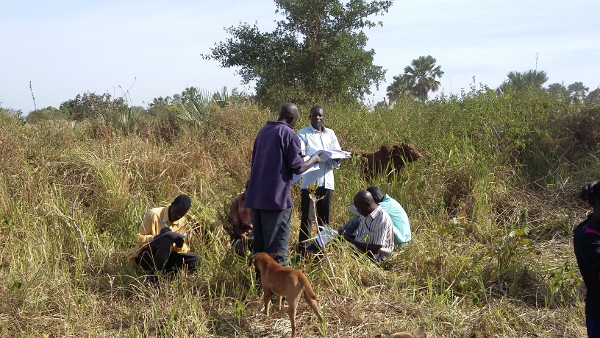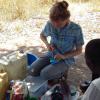In human patients rabies is almost 100% fatal. Which makes it the most deadly “killer” of all zoonotic infectious diseases. But there is hope that it could be eradicated in near future. Post-exposure prophylaxis is a successful treatment. However, it is very expensive and not always accessible in resource-poor regions. The most promising strategy is to vaccinate the majority of domestic dogs. Field evidence clearly supports this One Health approach. The global goal is to end the public health threat of rabies by 2030.

Rabies is a viral disease of humans and mammals which causes about 24,000 to 60,000 deaths worldwide per year [1], [2]. More than 95% of human deaths occur in Asia and Africa [3]. Infections occur following bite or scratch by an infected animal. Rabies causes a severe inflammation of the brain [1]. Human rabies cases develop neurological symptoms after a typical incubation period of one to three months [1].
Prophylactic vaccination in humans is highly protective [1]. However, due to high costs and possible side effects this preventive measure is only feasible and recommended for persons with a high occupational risk of rabies exposure, such as veterinarians. In unvaccinated humans, rabies is almost always fatal [3].
Post-exposure prophylaxis (PEP) is highly successful in preventing the disease, but only if administered fast enough (within less than 6 days after suspected infection) [4], [5]. However, the high costs of the mandatory course of 4 - 5 weekly post-exposure vaccinations (50,000 UGX ≈ 14 USD per single dose, for example in Uganda by February 2017), and in severe bite cases the administration of rabies immune globulin (RIG), often makes this life-saving treatment inaccessible for poor and vulnerable populations. This burden is aggravated by the occurrence of rabies mainly in remote rural communities where children between the age of 5–14 years become the predominant victims of the fatal disease [3].
An uninterrupted cooling chain which ensures the transport and storage of the vaccine and RIG doses at a constant temperature of 2-8 °C is essential for an effective PEP treatment. This poses a major challenge especially in remote areas with poor infrastructure. However, simply focusing on post-exposure treatment of human patients is neither sufficient nor feasible.
Compared to achieving so-called protective “herd immunity” by vaccinating at least 70% of all domestic dogs in a region, post-exposure prophylaxis of human dog-bite patients is extremely expensive and not a sustainable solution [6], [7], [8]. Field investigations in Africa and Asia could prove that canine mass vaccination acts as a reliable and cost-effective immunologic barrier against human exposure [9], [10].
While rabies and closely related viruses might never be completely eliminated due to their wildlife reservoirs, such as bats and wild carnivores [11], [12], [13], the eradication of dog-mediated human rabies is a realistic and worthwhile goal. Because more than 99% of all recorded human cases worldwide resulted from the bite of a domestic dog [14]. The World Health Organization (WHO), World Organization for Animal Health (OIE), Food and Agriculture Organization of the United Nations (FAO), and the Global Alliance for Rabies Control jointly advocate a global One Health framework. The main pillar of this interdisciplinary strategy is the vaccination of the majority of domestic dogs, including pet, working, and stray dogs in participating countries [15]. The goal of the campaign is to eliminate canine-mediated human rabies by 2030 [15].
References
[1] Giesen A, Gniel D, Malerczyk C. 30 Years of rabies vaccination with Rabipur: a summary of clinical data and global experience. Expert Rev Vaccines. 2015 Mar;14(3):351-67. doi: 10.1586/14760584.2015.1011134. Review. Erratum in: Expert Rev Vaccines. 2015 May;14(5):775. PubMed PMID: 25683583.
[2] GBD 2013 Mortality and Causes of Death Collaborators. Global, regional, and national age-sex specific all-cause and cause-specific mortality for 240 causes of death, 1990-2013: a systematic analysis for the Global Burden of Disease Study 2013. Lancet. 2015 Jan 10;385(9963):117-71. doi: 10.1016/S0140-6736(14)61682-2.PubMed PMID: 25530442; PubMed Central PMCID: PMC4340604.
[3] Rabies Fact Sheet N°99. World Health Organization. Updated March 2016, Retrieved 07 February 2017.
[4] Rabies. Guide for post-exposure prophylaxis. World Health Organization. Updated March 2016, Retrieved 07 February 2017.
[5] Lite J. Medical Mystery: Only One Person Has Survived Rabies without Vaccine—But How?. Scientific American. Oct 2008. Retrieved 18 March 2018.
[6] Lavan RP, King AI, Sutton DJ, Tunceli K. Rationale and support for a One Health program for canine vaccination as the most cost-effective means of controlling zoonotic rabies in endemic settings. Vaccine. 2017 Mar 23;35(13):1668-1674. doi: 10.1016/j.vaccine.2017.02.014. Epub 2017 Feb 16. Review. PubMed PMID: 28216188.
[7] Cleaveland S, Lankester F, Townsend S, Lembo T, Hampson K. Rabies control and elimination: a test case for One Health. Vet Rec. 2014 Aug 30;175(8):188-93. doi: 10.1136/vr.g4996. PubMed PMID: 25172649.
[8] Hampson K, Dushoff J, Cleaveland S, Haydon DT, Kaare M, Packer C, Dobson A. Transmission dynamics and prospects for the elimination of canine rabies. PloS Biol. 2009 Mar 10;7(3):e53. doi: 10.1371/journal.pbio.1000053. PubMed PMID: 19278295; PubMed Central PMCID: PMC2653555.
[9] Cleaveland S, Kaare M, Tiringa P, Mlengeya T, Barrat J. A dog rabies vaccination campaign in rural Africa: impact on the incidence of dog rabies and human dog-bite injuries. Vaccine. 2003 May 16;21(17-18):1965-73. PubMed PMID: 12706685.
[10] Tenzin, Wangdi K, Ward MP. Human and animal rabies prevention and control cost in Bhutan, 2001-2008: the cost-benefit of dog rabies elimination. Vaccine. 2012 Dec 17;31(1):260-70. doi: 10.1016/j.vaccine.2012.05.023. Epub 2012 May 23. PubMed PMID: 22634297.
[11] Fooks AR, Banyard AC, Horton DL, Johnson N, McElhinney LM, Jackson AC. Current status of rabies and prospects for elimination. Lancet. 2014 Oct 11;384(9951):1389-99. doi: 10.1016/S0140-6736(13)62707-5. Epub 2014 May 11. Review. PubMed PMID: 24828901.
[12] Office International des Epizooties, World Organization for Animal Health. Manual of Diagnostic Tests and Vaccines for Terrestrial Animals. 2015. Retrieved 18 March 2018.
[13] Rupprecht CE, Barrett J, Briggs D, Cliquet F, Fooks AR, Lumlertdacha B, Meslin FX, Müler T, Nel LH, Schneider C, Tordo N, Wandeler AI. Can rabies be eradicated? Dev Biol (Basel). 2008;131:95-121. Review. PubMed PMID: 18634470.
[14] World Health Organization. WHO Expert Consultation on Rabies: second report. (WHO technical report series ; no. 982). 2013. Retrieved 18 March 2018.
[15] World Health Organization, Organization International des Epizooties. Rationale for investing in the global elimination of dog-mediated human rabies. Report of the Rabies Global Conference, Geneva, Switzerland. 2015. Retrieved 18 March 2018.
Latest review
with special focus on advances in the development of new safe, effective and economic vaccines for domestic dogs, and oral vaccines for the control of the disease in wild animals. Therapeutic protocols used for the treatment of patients are also discussed.
El-Sayed A. Advances in rabies prophylaxis and treatment with emphasis on immunoresponse mechanisms. International Journal of Veterinary Science and Medicine. Available online 18 May 2018. ISSN 2314-4599. https://doi.org/10.1016/j.ijvsm.2018.05.001.
Additional information
General information by WHO
Less-known facts about rabies and its prevention
Wilson PJ and Rohde RE. 8 things you may not know about rabies – but should. Elsevier Connect. Epub 2015 Sept 28. Retrieved 19 March 2018.
Examples of projects with emphasis on prevention through vaccination of domestic dogs
Eliminating dog-mediated human rabies: Karachi determined to overcome a public health hazard
Campaigns and NGOs fighting rabies
- Log in to post comments

